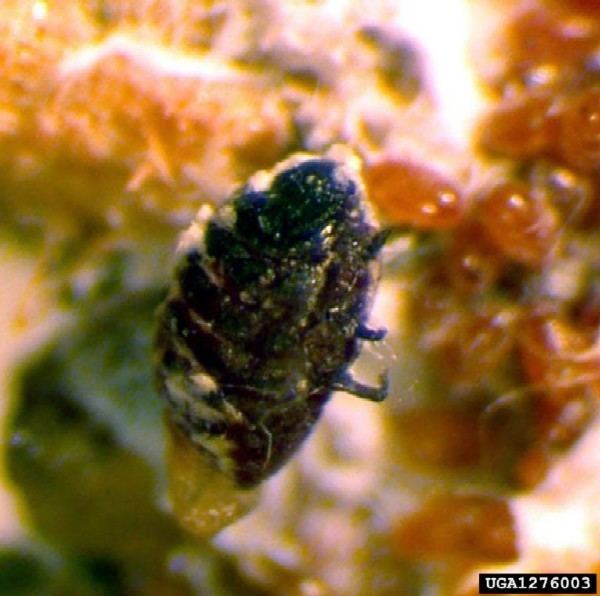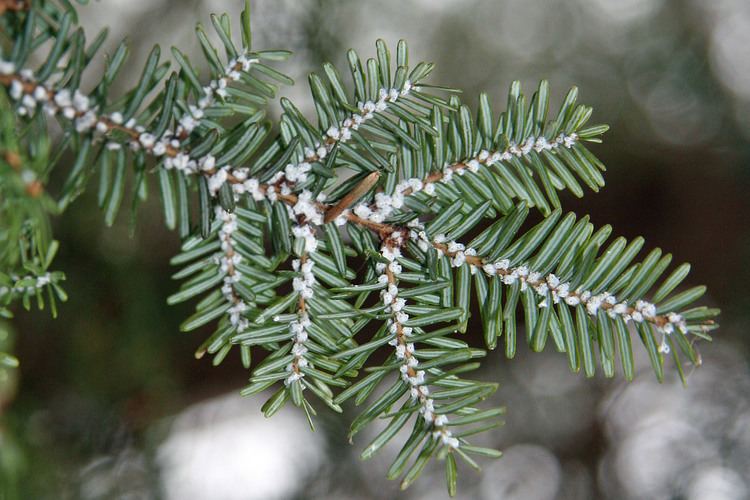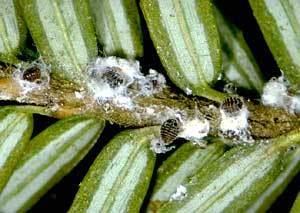Higher classification Adelges | Superfamily Phylloxeroidea Genus Adelges Rank Species | |
 | ||
Similar Adelgidae, Eastern hemlock, Adelges, Insect, Balsam woolly adelgid | ||
Tree shrub insects pests hemlock woolly adelgid magnolia scale winter moth caterpillar
Hemlock woolly adelgid (Adelges tsugae), or HWA, is member of the Sternorrhyncha suborder of the Order Hemiptera and native to East Asia. It feeds by sucking sap from hemlock and spruce trees (Tsuga spp.; Picea spp.). In eastern North America, it is a destructive pest that gravely threatens the eastern hemlock (Tsuga canadensis) and the Carolina hemlock (Tsuga caroliniana). Though the range of eastern hemlock extends north of the current range of the adelgid, it could spread to infect these northern areas as well. Accidentally introduced to North America from Japan, HWA was first found in the eastern United States near Richmond, Virginia, in the early 1950s. The pest has now been established in eighteen eastern states from Georgia to Massachusetts, causing widespread mortality of hemlock trees. As of 2015, 90% of the geographic range of eastern hemlock in North America has been impacted by HWA.
Contents
- Tree shrub insects pests hemlock woolly adelgid magnolia scale winter moth caterpillar
- Making it grow hemlock woolly adelgid
- Characteristics
- Forest level
- Treating individual trees
- Significance
- References
Making it grow hemlock woolly adelgid
Characteristics

The presence of HWA can be identified by its egg sacs, which resemble small tufts of cotton clinging to the underside of hemlock branches. Hemlocks stricken by HWA frequently become grayish-green rather than the dark green of healthy hemlocks. In North America, the hemlock woolly adelgid asexually reproduces and can have two generations per year. In its native Asian habitat is a third winged generation called Sexupera; this generation's reproduction requires a species of spruce that is not found in the Eastern United States and therefore dies there. Between 100 and 300 eggs are laid in the woolly egg sacs beneath the branches. Larvae emerge in spring and can spread on their own or with the assistance of wind, birds and/or mammals. In the nymph stage, the adelgid is immobile and settles on a single tree.

The hemlock woolly adelgid feeds on the phloem sap of tender hemlock shoots. It may also inject a toxin while feeding. The resulting desiccation causes the tree to lose needles and not produce new growth. In the northern portion of the hemlock's range, death typically occurs four to ten years after infestation. Trees that survive the direct effects of the infection are usually weakened and may die from secondary causes.
Forest level
The current leading biological control method of hemlock woolly adelgid is Pseudoscymnus tsugae. P. tsugae is a black lady beetle that is relatively host specific, feeding only on hemlock woolly adelgid, balsam woolly adelgid, and pine bark adelgid. This beetle was discovered feeding on hemlock woolly adelgid in its natural homeland of Japan in 1992. Since 1995 the DCNR's Bureau of Forestry has released more than 100,000 adult beetles in infested hemlock forests throughout Connecticut, New Jersey and Virginia to evaluate P. tsugae as a biological control agent. Experiments conducted in Connecticut and Virginia from 1995 through 1997 found that releasing adult P. tsugae beetles into an infested hemlock forest reduced adelgid densities by 47-88% within 5 months. The life cycle of P. tsugae is closely synchronized with the life cycle of the hemlock woolly adelgid. Both lay eggs in the spring and hatching occurs nearly simultaneously. When hatched, P. tsugae larvae are highly mobile and feed on hemlock woolly adelgid eggs and larvae. Each larva can consume about 500 adelgid eggs or from 50-100 immature adelgids.
Laricobius nigrinus is a beetle native to western North America and feeds only on woolly adelgids. L. nigrinus adults lay eggs on wintering hemlock woolly adelgid larvae. L. nigrinus larvae emerge and feed on hemlock woolly adelgid. L. nigrinus beetles can only complete their development by feasting on hemlock woolly adelgid.
Also under study is Laricobius osakensis from Japan, a relative of L. nigrinus. They have shown promise in field trials.
Treating individual trees
Insecticidal soap/horticultural oil is the environmentally safest chemical control method for hemlock woolly adelgid. These insecticides are non-toxic. They are applied to the foliage and kill the insect by smothering it as the spray dries. Most trees will need to be treated on a yearly basis.
Tree foliage insecticides are applied to the foliage of the tree and will persist on the foliage and continue killing hemlock woolly adelgid for up to two to four years after application. However, these materials are more toxic than insecticidal soaps/horticultural oils.
Soil drenches/soil injections/bark sprays are used in larger trees that cannot be completely sprayed with insecticidal soaps or foliage insecticides. Tree roots absorb and transport the product into the foliage and kill hemlock woolly adelgid. Soil drenches must be applied when there is adequate soil moisture for the tree roots to absorb the product. These products should not be used in areas that are in close proximity to bodies of water.
Trunk injections are used for large trees that are near water or where soils are too rocky for soil injections or drenches. The chemical is injected directly into the tree and transported to the twigs and needles where the hemlock woolly adelgids are feeding. Adequate soil moisture is also necessary for the tree to take up these products.
Significance
Hemlock is a vital component of the New England forest system, and is the third most prevalent tree in Vermont. Providing protection from erosion along stream banks, food for deer and wildlife, and shelter for deer in the winter, hemlock is also valued both as an ornamental and as an important source of lumber. Unlike the balsam woolly adelgid that attacked only mature balsam fir, HWA infests hemlocks of all ages. Where hemlock occurs in pure stands in that region, the most commonly observed tree species to succeed it is black (sweet) birch. Whereas in the southern extreme of its range, hemlock typically occurs not in pure stands but in linear riparian areas and other moist sites. Succession in these areas is affected by the presence of Rhododendron maximum which often coexists with hemlock, and because of a combination of influences restricts regeneration to shade and otherwise understory-tolerant plant species. Major changes in ecosystem structure and function, including hydrologic processes, are expected with the loss of hemlock.
One hopeful factor is that the adelgid does not seem able to survive prolonged or bitter cold. Following the winter of 1999-2000, a considerable dieback of adelgid and subsequent regrowth of infested trees was observed across Connecticut. The same phenomenon was repeated after the prolonged winter of 2013-2014, in time to save numerous nearly-succumbed forests.
A 2009 study conducted by scientists with the U.S. Forest Service Southern Research Station suggests the hemlock woolly adelgid is killing hemlock trees faster than expected in the southern Appalachians, and rapidly altering the carbon cycle of these forests. According to Science Daily, the pest could kill most of the region's hemlock trees within the next decade. According to the study, researchers found "hemlock woolly adelgid infestation is rapidly impacting the carbon cycle in [hemlock] tree stands", and "adelgid-infested hemlock trees in the South are declining much faster than the reported 9-year decline of some infested hemlock trees in the Northeast." In fact, as of 2007 the rate was recorded as 15.6 km/year south of Pennsylvania and 8.13 km/year (or less) in the northern section of the HWA’s range.
